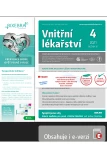Monitoring the dynamics of clinical and laboratory markers of chronic heart failure during 12 months of sacubitril/valsartan treatment
Authors:
Jana Čepelová 1; Marek Malý 2; Josef Daněk 1; Martin Malý 1
Authors‘ workplace:
Interní klinika 1. LF UK a ÚVN, Ústřední vojenská nemocnice, Vojenská fakultní nemocnice, Praha
1; Oddělení biostatistiky, Státní zdravotní ústav, Praha
2
Published in:
Vnitř Lék 2021; 67(4): 212-217
Category:
Original Contributions
Overview
Aim: Treatment with sacubitril/valsartan (S/V) significantly improves cardiovascular morbidity, mortality, quality of life and prolongs the survival of chronic heart failure patients with reduced ejection fraction. The aim of the study was to evaluate changes in ejection fraction, NT-proBNP and glomerular filtration after 12 months of sacubitril/valsartan treatment.
Methods: 30 patients (28 men) with chronic heart failure with reduced ejection fraction, functional classes NYHA II-III, EF LK < 40%, NT-proBNP (> 450 ng/l), with glomerular filtration > 0.5 ml/s/1.73 m2, with a potassium < 5.4 mmol/l were classified in the study. S/V treatment was started at systolic blood pressure > 100 mmHg. Ejection fraction, glomerular filtration rate and NT-proBNP values were compared before treatment and after 12 months of S/V treatment. The number of hospitalizations and deaths was also monitored.
Results: During 12 months of S/V treatment there was a significant improvement in left ventricular ejection fraction (median initial 26.3%, after treatment 36.3%, difference 7.5%, p <0.001), there was an improvement in glomerular filtration (median initial 0.90 ml/s, after treatment 0.97 ml/s, difference 0.06 ml/s, p < 0.01) and a significant reduction in NT-proBNP (median initial 1363.0 ng/l, after treatment 647.0 ng/l, difference – 600.0 ng/l, p < 0.001). The NYHA functional class has been improved by I grade in 33.3% of patients, in 63.3% the clinical condition was stationary. Systolic and diastolic blood pressure after 12 months were the same in 50.0% and in 53.3% of patients, respectively. Hospitalization for heart failure was necessary in 5 (16.6%) patients, no deaths occurred. No patient had to discontinue S/V therapy. The maximum dose of S/V 97/103 mg was achieved in 33.3% of patients, the limitation of titration was hypotension. Conclusion: Sacubitril/Valsartan is an effective, safe, and affordable drug that significantly improves the prognosis of chronic heart failure patients with reduced ejection fraction, improves quality of life, reduces hospitalizations, and prolongs survival.
Keywords:
heart failure – renin – angiotensin – natriuretic peptides – dual inhibition – sacubitril/valsartan – LCZ696
Sources
1. Ponikowski P, Voors AA, Anker SD et al. 2016 ESC Guidelines for the diagnosis and treatment of acute and chronic heart failure: the Task Force for the diagnosis and treatment of acute and chronic heart failure of the European Society of Cardiology (ESC). Developed With the special contribution of the Heart Failure Assotiation (HFA) of the ESC. Eur J Heart Fail 2016; 18: 891–975.
2. McMurray JJ, Packer M, Desai AS et al. Angiotensin-neprilysin inhibitor versus enalapril in heart failure. N Engl J Med 2014; 371: 993–1004.
3. Packer M, McMurray JJ, Desai AS et al. Angiotensin receptor neprilysin inhibition compared with enalapril on the risk of clinical progression in surviving patients with heart failure. Circulation 2015; 131: 54–61.
4. Lewis EF, Claggett BL, McMurray JJV et al. Assessing health- related quality of life in patients with heart failure: a systematic, standardized comparison of available measures. Heart Fail Rew 2014; 19: 359–367.
5. Jaffe AS, Apple FS, Mebazaa A et al. Unraveling N-terminal pro-B-type natriuretic peptide: another piece to a very complex puzzle in heart failure patients. Clin Chem 2015; 61: 1016–1018.
6. Troughton RW, Frampton CM, Yandle TG et al. Treatment of heart failure guided by plasma aminoterminal brain natriuretic peptide (N-BNP) concentrations. Lancet 2000; 355: 1126–1130.
7. Docherty KF, Vaduganathan M, Solomon SD et al. Sacubitril/Valsartan, Neprilysin Inhibition 5 Years After PARADIGM-HF. J Am Coll Cardiol 2020; 10: 800–810.
8. Januzzi JL, Prescott MF, Butler J, et al. Association of change in n-terminal pro b-type natriuretic peptide following initiation of sacubitril-valsartan treatment with cardiac structure and function in patients with heart failure with reduced ejection fraction. JAMA 2019; 322: 1077–1084.
9. Srivastava PK, Clagget BL, Solomon SD, et al. Estimated 5-year number needed to treat to prevent cardiovascular death or heart failure hospitalization with angiotensin receptor- neprilysin inhibition vs standard therapy for patients with heart failure with reduced ejection fraction. JAMA Cardiol 2018; 3: 1226–1231.
10. Velazquez EJ, Morrow DA, DeVore AD et al. Angiotensin-neprilysin inhibition in acute decompensated heart failure. N Engl J Med 2019; 380: 539–548.
Labels
Diabetology Endocrinology Internal medicineArticle was published in
Internal Medicine

2021 Issue 4
Most read in this issue
- Chronic obstructive pulmonary disease: diagnosis and treatment of stable phase of disease; personalized treatment approach using phenotype features of the disease Summary of the 2020–2021 Czech Pneumological and Phthiseological Society position paper
- Thymoma – disease of many faces
- Targeted and biological drugs in the treatment of inflammatory rheumatic diseases
- Biologic therapy for dyslipidemia
